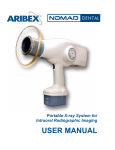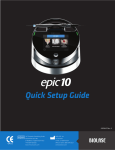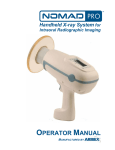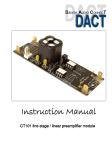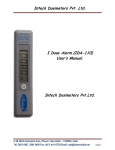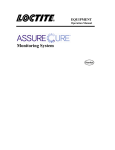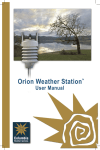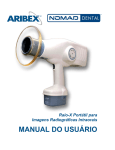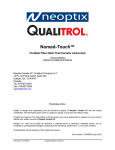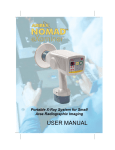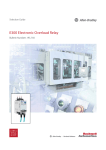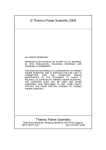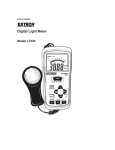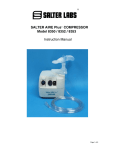Download NOMAD Dental “Getting Started”
Transcript
TM MANUFACTURED BY GETTING STARTED This quick reference guide is intended to supplement the User Manual and operator training materials located on the NOMAD Operator Training CD. BASIC OPERATION Attach a fully charged battery (see Battery Care). Turn power on by pressing the POWER button. To change exposure settings press the increase or decrease buttons. (Example, 08 LED display setting = 0.08 seconds; 35 LED display setting = 0.35 seconds.) NOTE: Manual and some training materials are also available for download on the Aribex website at www.aribex.com or they can be ordered in hard copy format: [email protected] The standard package system includes the following items. 2 Charged Batteries, Battery Charger (the charger should be appropriate for local AC line voltage), Certificate of Conformance, Warranty Card, and NOMAD Operator Training CD. Verify that the serial number on the Warranty / Registration card matches the X-ray device serial number and the device serial number on the carrying case. Please complete the product Warranty / Registration card and mail it with proper postage to Aribex today. Completing the card fulfills a condition of warranty coverage. Review the User Manual and training material contained on the CD shipped with this device. Each battery can go through the full (dis)charge cycle approximately 200 times. Routinely change out a discharged battery with fully charged one, as needed. A flashing, yellow LOW BATTERY indicator ☼ (control panel) and intermittent audible signal indicate the need for a freshly charged battery. A battery can be left indefinitely in the plugged-in charger without damaging batteries. When the charging indicator stops flashing, leaving the battery in the charger for 8 hours helps to maintain optimum battery capacity (equalization). and check for any noticeable signs of damage – do not use the device if it shows signs of damage. For more on adjusting the time settings see the User Manual contained on the CD. Press and release ENABLE to ready the device. Position the NOMAD relative to the receptor. To begin the exposure, squeeze the handle trigger (or press and hold START) until the audible, signal ends, and green START and yellow X-RAYS ON indicators are off. Turn off the power by pressing the POWER button. Do not operate NOMAD or battery charger if equipment was subjected to moisture. Do not spray disinfectant or cleaners directly on the NOMAD or battery charger. Damage to your device or a shock hazard may result. Consult the User Manual on the CD for proper cleaning instructions. Do not open the housings. Doing so will void the warranty. There are no user-serviceable parts inside the NOMAD or battery charger. Locate the charging system away from the normal patient environment. NOMAD should not be operated if it has been dropped or performance degrades; it should be returned to Aribex for a safety check. LIMITED WARRANTY The following are important battery care notes: Charge only between +4°C (+39°F) and +40°C (+104°F). Recommended charging temperature is +24°C (+75°F). Unwrap each component from the protective plastic NOMAD Device with Backscatter Shield attached, BATTERY CARE Battery charge will diminish during extended inactivity – fully recharge handsets every 3 months during inactivity. Never place a low charge battery into long-term storage. Do not store batteries in extreme conditions: below –20°C (–4°F) or above +40°C (+104°F), or beyond 95% relative humidity (non-condensing). The optimal storage location is cool, dry, and away from direct sunlight. Do not store or carry batteries so that battery terminals can be damaged or exposed to contact with conductive objects. Always unplug the charger from the power supply when it is not in use. For additional info, specifically about the charger, see the accompanying instruction manual for the battery charger. Do not attempt to charge damaged batteries. When the battery charger senses a bad battery, it is spent and must be taken out of service. Do not use batteries from other sources. Properly dispose of spent or damaged batteries; return to Aribex or an authorized distributor for replacement and recycling. Do not place in municipal waste stream. COVERAGE. Aribex, Inc. warrants its medical and dental x-ray equipment to be free from any defects in material or workmanship for a period of one (1) year from the date of purchase. Aribex, Inc. also warrants any accessories purchased from Aribex to be free from any defects in material or workmanship for the period of one (1) year from the date of purchase. The liability of Aribex, Inc. is limited to repair or replacement of any parts that Aribex or its authorized resellers determine to be defective. Contact Aribex for a Return Material Authorization (RMA) number and shipping instructions. Parts proving defective shall be repaired or replaced free of charge (labor and domestic shipping included), if defective equipment is returned freight collect to Aribex (Utah, USA) or the location of the authorized service center. Equipment repaired or replaced under warranty shall continue to be warranted for the balance of the original warranty term. All warranty claims must be made not later than ten (10) business days following the expiration of the applicable warranty period. LIMITATIONS OF COVERAGE. This warranty does not apply to equipment that is or has been abused, misused, or altered (including opening enclosure or tampering), improperly maintained, subjected to use beyond rated conditions, or damaged as a result of any carelessness or accidents. This warranty does not cover ordinary wear and tear or maintenance. LIMITATIONS OF LIABILITY. Aribex, Inc. makes no other warranty, either expressed or implied, with respect to any equipment purchased from Aribex, including without limitation any implied warranties of merchantability or fitness for a particular purpose, whether or not Aribex may have been informed of the actual uses to which any of such equipment may be put. Aribex, Inc. shall not under any circumstance be liable for incidental, indirect, consequential, punitive or exemplary damages, including without limitation damages for delay or lost profits, and in no event shall liability of Aribex arising from the purchase, sale or use of the equipment, or breach of any warranty made above, exceed in the aggregate the purchase price paid therefore. EC 0473 ISO 13485 / ISO 9001 CERTIFIED COMPANY Aribex, Inc. 744 South 400 East Orem, Utah 84097 U.S.A. REP MT Promedt Consulting Altenhofstr. 80 66386 St. Ingbert Germany Phone: 801-226-5522 Fax: 801-434-7233 Email: [email protected] http://www.aribex.com U.S. patents 7,224,769 and 7,496,178 United States and international patents pending © Aribex, Inc. 2010 All Rights Reserved MP-0113-A THE NOMAD DIFFERENCE RADIATION SAFETY ® NOMAD is safe to be used as a handheld X-ray source. There is no need to leave the room during an exposure. 2) Backscatter – When properly oriented, the transparent shield on NOMAD collimator acts as a barrier against backscatter radiation, making it safe for the operator to stay in the room. Operators must follow all applicable regulatory guidelines and inhouse radiation protection program in regard to patients and operators who are pregnant or expect to become pregnant. Do not attempt an exposure if anyone other than patient is in the direct beam. If others are assisting, then they should wear protective covering. 1) Leakage – Unique internal shielding of NOMAD encases the X-ray tube eliminating leakage radiation. As demonstrated by the data below, this makes it safe to use NOMAD as a handheld device during exposures. When selecting and using Position Indicating Devices (PIDs), preference should be given to models that allow the backscatter shield to remain at the outer end of the collimator cone for maximum operator protection. Fixed Beam Limiting Device Optimal operator radiation backscatter protection exists when: a) The backscatter shield is positioned at the outer end of the collimator cone. b) The backscatter shield is close to the patient. c) The patient tilts their head when needed to accommodate exposures. d) The operator remains within the significant zone of occupancy immediately behind the device shield. X-ray Source Focal Spot An exposure can be terminated for any reason by abruptly releasing the depressed trigger. Backscatter Radiation Shielding Comparative Data for Whole Body Exposure (Annual) Primary Protective Shielding Comparative Data for Hand and Extremity Exposure (Annual) 500mSv Occupational Dose Limit 1 50mSv Occupational Dose Limit Requiring Dosimetry1 0.43mSv 2 0.22mSv Average Using NOMAD with D-Speed Film Average Using NOMAD with F-Speed Film or Digital Sensor2 1) Standards for Protection against Radiation, 10 CFR 20 (US Federal Standards), 1994 (see also NCRP Report No. 116) 2) "Radiation Exposure with the NOMAD Portable X-ray System", Goren AD et al, Dentomaxillofacial Radiology, 37 (2008), S. 109-12; normalized average (includes leakage and backscatter radiation) assumes 7,200 exposures per year, and the average length of exposure for D-speed = 0.50 seconds, F-speed = 0.25 seconds, digital sensor = 0.20 seconds 50mSv Occupational Dose Limit1 5mSv 1 Occupational Dose Limit Requiring Dosimetry 3.65mSv Average Natural Background Radiation2 2.19mSv 3 Average Occupational Radiation for Flight Crews 1.00mSv General Public Dose Limit1 0.20–0.70mSv Range for Dental Personnel Using Conventional X-rays2 0.30mSv 4 Average Using NOMAD with D-Speed Film As shown in graphic representations, maximum protection (green area) from backscatter radiation (red area) exists when the NOMAD is positioned near the patient, is perpendicular to the operator with the patient (oval) positioned/tilted as needed, and the backscatter shield is fully extended toward the patient. As a result of the internal and backscatter shielding, operator X-ray exposure is far below federal regulatory limits. Slow series of short, double beeps Function / Resolution System Readiness: Activates when ENABLE is pressed/ released; ends automatically after 30 seconds or when an exposure starts (trigger is depressed or START is pressed). Green START and yellow X-RAYS ON indicators illuminate X-ray Exposure: At the end of the successful exposure, audible signal and indicators stop. Continuous tone (for the duration of the timed exposure) Green START and yellow X-RAYS ON indicators flash Incomplete Exposure: Activates if trigger is released before the timed x-ray exposure finishes and ends automatically after 15 seconds or if power is manually turned off/on. Series of long beeps LED display turns off Two short beeps System Alert, followed by a system shutdown: X-ray emissions are not detected during timed exposure but the battery is OK. Yellow LOW BATTERY indicator flashes 0.12mSv Average Using NOMAD with F-Speed Film or Digital Sensor4 1) Standards for Protection against Radiation, 10 CFR 20 (US Federal Standards), 1994 (see also NCRP Report No. 116) 2) NCRP Report No. 145 (National Council on Radiation Protection and Measurements), p7-9 3) "Estimated Cosmic Radiation Doses for Flight Personnel", Feng YJ et al, Space Medicine and Medical Engineering, 15(4) 2002, p265-9 4) Normalized average assumes 7,200 exposures per year, and the average length of exposure for D-speed = 0.50 seconds, F-speed = 0.25 seconds, digital sensor = 0.20 seconds Alert Green ENABLED indicator flashes Operators must be fully acquainted with industry safety recommendations and established maximum permissible doses. Do not enable NOMAD until patient and operator are positioned and ready for the exposure, preventing interruption and inadvertent exposure of anyone to X-rays. Aside from the direct beam, X-ray devices have two potential operator radiation sources: 1) leakage radiation and 2) backscatter radiation bouncing back off the subject. ALARMS AND ALERTS Low Battery: Replace the battery and reset exposure time. Slow series of short beeps Proper postioning PROTECTION: MAXIMUM Held back Shield slid back Non-perpendicular MINIMIZED Operation outside the protection zone (or with a diminished protective zone) requires proper precautions such as the use of lead aprons. Alarm LED display begins flashing Series of long beeps Function / Resolution Overheating: Operation suspends if the device overheats; after cooling for approximately 5 minutes (or longer depending upon room temperature), power on.



